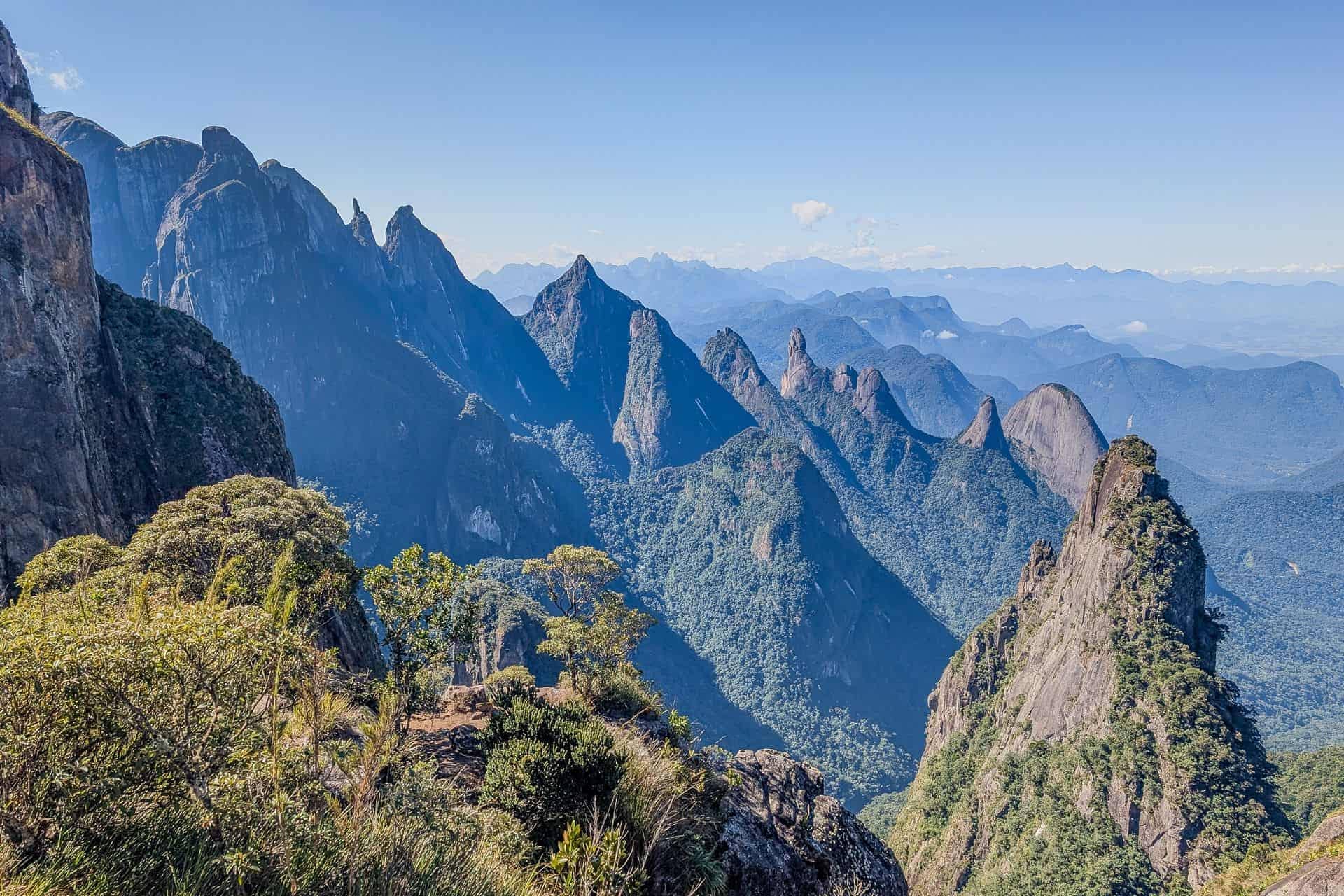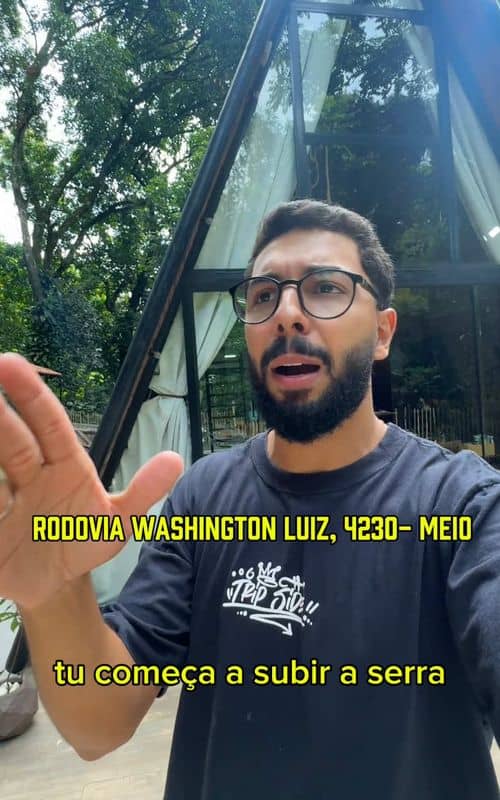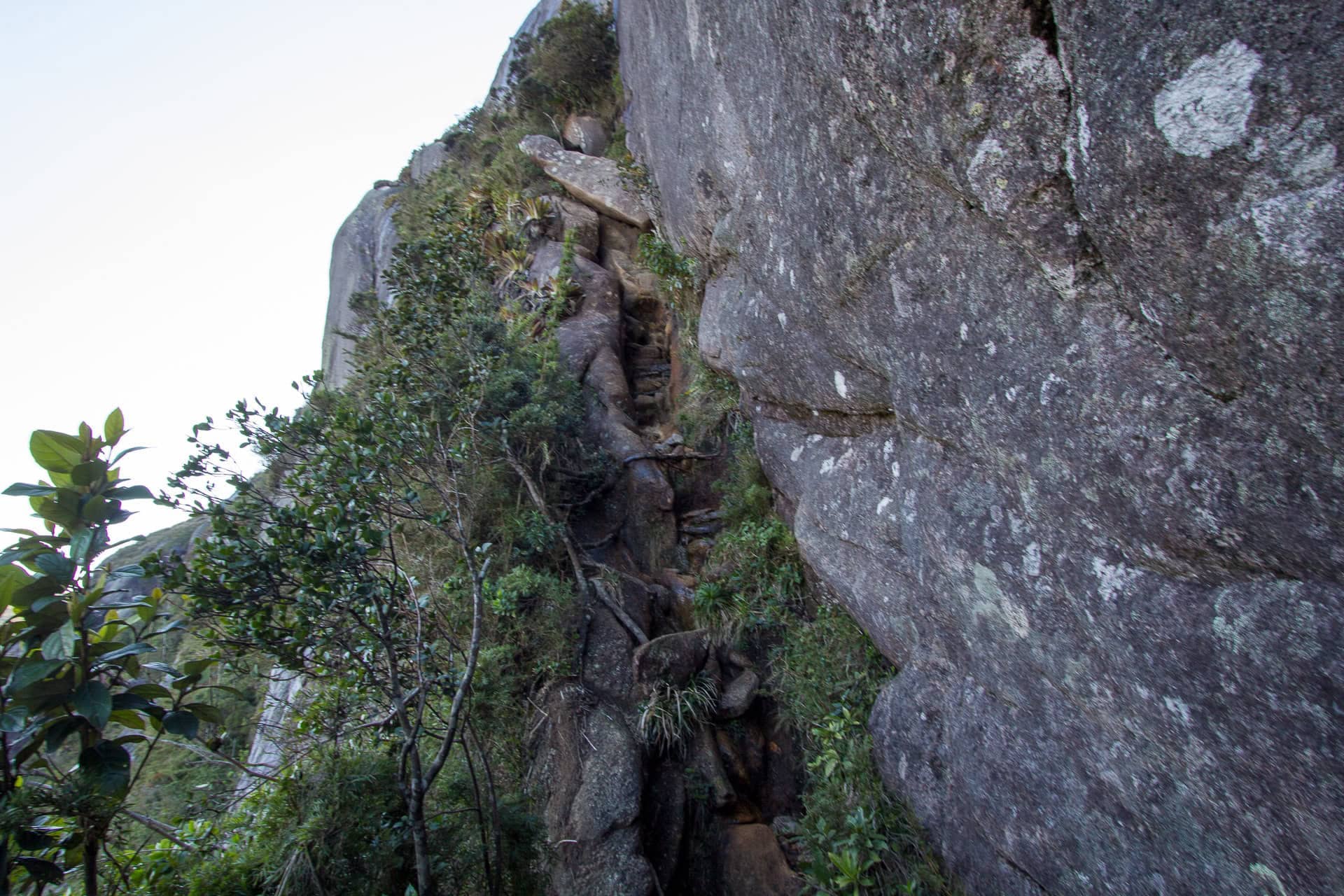Petrópolis-Teresópolis Traverse
A challenging multi-day trek through stunning mountain landscapes, testing your endurance and rewarding you with unforgettable vistas.

Highlights
Must-see attractions

Social
From TikTok & Reddit
Best Time
Pleasant weather for hiking
Petrópolis-Teresópolis Traverse
Best Time
Pleasant weather for hiking

Highlights
Must-see attractions
A challenging multi-day trek through stunning mountain landscapes, testing your endurance and rewarding you with unforgettable vistas.
"One of the most beautiful traverses I've ever done, the views are worth every step!"
Assess Your Fitness Level
This trek is demanding. Ensure you have good physical and psychological preparation. :athletic_shoe:
Camping Gear is Essential
Shelters might be deactivated; plan to camp. Bring a reliable tent and sleeping bag. :tent:
Highlights
Discover the most iconic attractions and experiences

Castelo do Açu
First night camping spot
A stunning campsite with breathtaking views, often the first major stop on the traverse.

Pedra do Sino
Second night camping spot
The second major camping area, offering a different perspective of the mountainous landscape.

Technical Sections
Between Açu and Sino
Challenging but rewarding passages like 'Elevador,' 'Cavalinho,' and 'Mergulho' test your mettle.
Plans like a pro.
Thinks like you
Planning Your Visit
Prepare for a Challenging Trek
Shelter Status & Water Sources
Best Times
Insider Tips
from TikTok, Instagram & Reddit
Assess Your Fitness Level
This trek is demanding. Ensure you have good physical and psychological preparation. :athletic_shoe:
Camping Gear is Essential
Shelters might be deactivated; plan to camp. Bring a reliable tent and sleeping bag. :tent:
Water is Plentiful
Natural water sources are abundant. Refill your bottles frequently. :droplet:
Pack Light but Smart
Carry essentials, but avoid excess weight. Every pound counts on steep ascents. :backpack:
Tips
from all over the internet
Assess Your Fitness Level
This trek is demanding. Ensure you have good physical and psychological preparation. :athletic_shoe:
Camping Gear is Essential
Shelters might be deactivated; plan to camp. Bring a reliable tent and sleeping bag. :tent:
Water is Plentiful
Natural water sources are abundant. Refill your bottles frequently. :droplet:
Pack Light but Smart
Carry essentials, but avoid excess weight. Every pound counts on steep ascents. :backpack:
Consider a Guide for Beginners
While possible without a guide, beginners might find it safer and more informative with one. :hiking_boot:
What Travellers Say
Reviews Summary
The Petrópolis-Teresópolis Traverse is lauded as one of the most beautiful hikes, offering breathtaking views that make the challenging journey worthwhile. Hikers praise the well-maintained trails and the abundance of natural water sources. However, the trek is physically and psychologically demanding, with technical sections that can be intimidating for the unprepared.
"Fiz a travessia em Maio de 2023. Realizada em três dias, os abrigos estavam desativados, então dormi duas noites em barraca. A primeira foi no Castelo do Açú, a segunda próximo à Pedra do Sino. Ambos próximos aos abrigos desativados. O trecho do segundo dia, entre o Açu e o Sino exige mais condicionamento físico e preparo para passar por alguns pontos mais técnicos e que pode dar medo para pessoas que não estejam acostumadas com altura, são os trechos conhecidos como elevador, cavalinho e mergulho. A travessia é belíssima, a vista por todo o percurso compensa muito! Há diversos pontos onde pôde-se abastecer as garrafas de água em cursos d’água. O primeiro dia fizemos em 5h, o segundo dia em 10h e o terceiro em 5h. Fiz no sentido Petrópolis/Teresópolis."
Pedro Borges
"Lugar incrível com muitas subidas e descidas com dois dias uma meta e sonho realizado"
Antonio Proença
"Nessa última passagem minha pelo Açu, as trilhas estavam com manutenção em dia, boa de fazer. E a beleza do lugar é tão grande que toda vez que vou, parece ser a primeira."
Teken Wel
What People Like
What People Dislike
Frequently Asked Questions
🚇 🗺️ Getting There
The traverse typically starts in Petrópolis and ends in Teresópolis, or vice-versa. You'll need to arrange transportation to the trailhead in Petrópolis and from the endpoint in Teresópolis. Research local bus services or private transfers for both ends of the journey.
Most hikers start from the Quitandinha neighborhood in Petrópolis. You can reach Petrópolis by bus from Rio de Janeiro. From the city center, you might need a taxi or local bus to get to the specific starting point of the trail.
Once you complete the traverse in Teresópolis, you can find bus services back to Rio de Janeiro or other nearby cities. Taxis are also available from the trail's end point.
No, the Petrópolis-Teresópolis Traverse is a multi-day hike, typically taking 3 days to complete. It's not feasible as a day trip due to its length and terrain.
The most common way to travel between the two cities is by bus. Several companies operate routes connecting Petrópolis and Teresópolis, making it convenient for planning your start and end points.
🎫 🎫 Tickets & Entry
While specific entry tickets are not always required for the trail itself, it's crucial to check for any park regulations or permit requirements, especially if entering national park areas. Conditions can change, so always verify beforehand.
Generally, the trail is accessible without a direct entrance fee. However, some sections might pass through protected areas where fees could apply. It's best to confirm with local park authorities or trail guides.
Accommodation on the trail primarily consists of camping. Shelters may be available but are often deactivated. You'll need to bring your own camping gear and find suitable spots, often near former shelter locations like Castelo do Açu or Pedra do Sino.
The trail is open 24/7, as it's an outdoor hiking route. However, daylight hours are essential for safe navigation, especially through technical sections. Plan your hiking days accordingly.
As there are typically no direct tickets or booking fees for the trail itself, refund policies don't usually apply. Your costs will be related to transportation and personal gear.
🎫 🥾 Onsite Experience
This traverse is considered difficult and is recommended for experienced hikers. It involves significant elevation changes, technical sections, and requires good physical and mental endurance. Beginners should seriously consider a guide.
The traverse is typically completed in three days. Each day involves several hours of hiking, with the second day often being the longest and most challenging, covering the technical sections between Açu and Sino.
Key technical sections include 'Elevador,' 'Cavalinho,' and 'Mergulho.' These require careful footing and can be intimidating for those with a fear of heights. No rappelling or ropes are generally needed, but good balance is crucial.
While experienced hikers may attempt it solo, it's highly recommended for beginners to hire a guide. A guide can help with navigation, safety, and provide valuable insights into the trail's challenges.
Expect a mix of steep ascents and descents, rocky paths, and some exposed ridges. The terrain is varied, demanding good hiking boots and careful navigation throughout the trek.
🍽️ 💧 Food & Water
There are numerous natural water sources, such as streams and springs, along the trail. You can refill your water bottles at these points. It's always a good idea to have a water filter or purification tablets as a backup.
Yes, you will need to carry all your food for the duration of the traverse, as there are no facilities or shops along the route. Plan your meals carefully to ensure you have enough sustenance.
Pack lightweight, high-energy foods such as dehydrated meals, energy bars, nuts, dried fruits, and jerky. Focus on non-perishable items that are easy to prepare and provide maximum calories.
No, there are no restaurants or food stops on the Petrópolis-Teresópolis Traverse. You must be self-sufficient for all your food and water needs.
While water sources are available, it's wise to carry at least 2-3 liters of water per person at any given time, especially during drier periods or when moving between known water points.
📸 📸 Photography
The entire traverse offers stunning panoramic views. Key spots include the summits near Castelo do Açu and Pedra do Sino, as well as along the ridge lines. Sunrise and sunset can provide spectacular lighting.
A lightweight camera setup is ideal. Consider a wide-angle lens for landscapes and a telephoto lens for distant peaks. A sturdy tripod can be useful for low-light conditions, but ensure it's easy to carry. Protect your gear from dust and moisture.
Don't miss the views from the campsites at Castelo do Açu and Pedra do Sino. The dramatic rock formations and expansive valleys offer incredible photographic potential. The technical sections also present unique, albeit challenging, photo opportunities.
The 'golden hours' around sunrise and sunset offer the most dramatic and beautiful light for landscape photography. Midday sun can be harsh, but it's still possible to capture the rugged beauty of the terrain.
Use a waterproof camera bag or cover, especially during potential rain. Keep your camera in a readily accessible but protected pocket or compartment of your backpack. Consider lens cleaning cloths for dust and moisture.
For Different Travelers
Tailored advice for your travel style
👨👩👧 Families with Kids
If a family is keen on experiencing the Serra dos Órgãos National Park, it would be far more suitable to explore shorter, less strenuous day hikes within the park that are specifically marked as family-friendly. These might include trails with less elevation gain and fewer technical challenges, allowing children to enjoy the natural beauty without the extreme demands of a multi-day traverse.
🎒 Budget Travelers
To save money, opt for public bus transportation between cities. Pack your own food, focusing on non-perishable, high-energy items. If you don't own camping gear, consider borrowing from friends or looking for rental options in Petrópolis or Teresópolis, though this might add to the cost. Hiring a guide can be an expense, but for beginners, it's a worthwhile investment in safety and experience.
🚶 Solo Adventurers
It's crucial to inform someone of your itinerary and expected return time. Carry a reliable communication device (like a satellite messenger if cell service is unreliable) and be prepared for emergencies. While the trail is marked, the technical sections and potential for changing weather demand constant vigilance. Consider joining a group or hiring a guide for your first solo attempt if you have any doubts about your capabilities.
Deep Dives
In-depth insights and expert knowledge
Navigating the Technical Sections
Elevador often refers to a steep, rocky climb that can feel like ascending a natural staircase. Cavalinho (little horse) might describe a narrow ridge or a section where you need to straddle a rock formation. Mergulho (dive) could indicate a steep descent or a section that requires careful maneuvering. These parts are what make the traverse a true test of a hiker's skill and nerve, offering a sense of accomplishment upon completion.
For those new to such terrain, it's highly advisable to hike with an experienced guide. They can provide crucial advice on foot placement, pacing, and safety. Even for seasoned hikers, these sections demand respect and focus. The stunning views from these high points are a significant reward, but safety must always be the top priority.
Camping and Shelter Logistics
Carrying a reliable tent, sleeping bag, and sleeping pad is essential. You'll need to identify suitable, established camping spots, often found near the former shelter locations. These areas usually offer relatively flat ground and some protection from the elements. Always practice Leave No Trace principles, ensuring you pack out everything you pack in and minimize your impact on the environment.
While shelters may be deactivated, the presence of natural water sources is a major advantage. Streams and springs are common along the trail, allowing you to refill your water supply. However, it's always prudent to carry a water filter or purification tablets as a backup, especially during drier periods.
Best Times to Tackle the Traverse
Even during the dry season, mountain weather can be unpredictable. Be prepared for temperature fluctuations, especially at higher altitudes. Mornings are often clearer, offering better visibility for the stunning vistas. While crowds are generally not as intense as in more accessible tourist spots, popular weekends or holidays might see more hikers on the trail.
It's crucial to check weather forecasts immediately before your departure and be prepared to postpone your trip if conditions are unfavorable. Safety is paramount, and attempting the traverse in adverse weather can significantly increase the risks, particularly in the technical sections.

Social
from TikTok, Instagram & Reddit